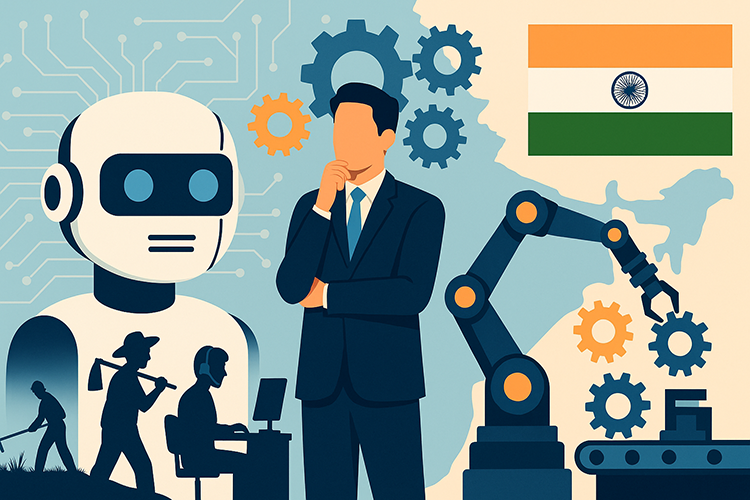AI and the future of work in India: balancing automation and employment
Artificial intelligence is reshaping India’s labour market at speed. Prime Minister Narendra Modi has argued that “AI can help transform millions of lives,” citing opportunities in health, education and agriculture—a view he voiced at a Summit in Paris earlier this year. Yet the same technologies are unsettling employers and workers as companies automate routine tasks and reorganise white-collar work.
A growing body of evidence shows the impact will be uneven rather than uniformly job-destroying. The International Monetary Fund estimates that about 40% of global employment is exposed to AI; exposure is lower in emerging markets, with roughly 26% of Indian workers in highly exposed roles, compared with roughly 60% in advanced economies. The World Economic Forum’s Future of Jobs 2025 report foresees large, simultaneous waves of job creation and displacement worldwide, tilting demand toward technology, green and care-economy roles.
Several recent estimates suggest AI is already a net creator of specialised roles in India—provided skills keep up. Research commissioned by ServiceNow projects 2.73 million additional tech jobs in India by 2028 as firms adopt AI at scale, a view echoed by Indian media and industry bodies tracking the talent pipeline. NASSCOM and BCG, meanwhile, expect the domestic AI market to reach roughly $17 billion by 2027, underpinned by rising enterprise spend and one of the world’s deepest AI-skills pools.
At the same time, disruption is visible. Reuters reported in August 2025 that Tata Consultancy Services would cut “over 12,000” roles—India’s largest private-sector layoff—framed by analysts as an early sign of AI-driven restructuring across the $283 billion outsourcing sector. Policymakers and employers are responding with large-scale skilling efforts, including the government’s IndiaAI Mission (approved March 2024 with more than ₹10,300 crore to expand compute and talent) and the MeitY–NASSCOM FutureSkills Prime initiative, which subsidises AI training.
Agriculture. Agriculture still employs roughly 40–46% of India’s workforce, depending on the measure and year, which makes productivity-enhancing tech particularly consequential. The government’s Digital Agriculture Mission is deploying data platforms—such as the Agri-Stack and Krishi Decision Support System—for price forecasting, crop estimation and soil-suitability analytics; these tools have begun to filter into advisory services for farmers. The emphasis in agriculture is less “job replacement” than augmenting yields and incomes.
Manufacturing. Generative and “agentic” AI are expected to reconfigure shop-floors and supply chains. A widely cited ServiceNow-linked analysis suggests AI could affect 1.8 crore jobs across manufacturing, retail and education by 2030, with about 80 lakh roles in manufacturing most exposed to change. The figure reflects roles being transformed or re-tasked—not necessarily eliminated—conditional on reskilling.
IT & services. This is where short-term displacement risks are sharpest, particularly for mid-career “people managers,” testers and basic support roles—exactly the cohorts flagged in the TCS restructuring. Yet AI is also spawning demand for machine-learning engineers, data product managers and safety/validation specialists. NASSCOM-BCG data show more than 420,000 professionals already in AI roles, with demand rising around 15% annually through 2027. Even in business-process outsourcing, automation is not purely subtractive: reporting on India’s call-centre sector finds AI tools creating new roles and lifting productivity, even as routine tasks are automated.
Some public claims need calibration. The idea that India will add “400,000 AI jobs by end-2025” is not borne out in recent primary sources; more robust, current projections cluster around multi-year horizons—such as ~2.7 million AI-adjacent roles by 2028—tied to training capacity and enterprise adoption.  Likewise, sweeping estimates that “69% of India’s (formal/informal) jobs could be automated by 2030” are not reflected in IMF or WEF baselines; the best-available cross-country work puts India’s high-exposure share closer to one-quarter, with outcomes highly sensitive to skilling and task redesign.
India’s near-term challenge is to turn exposure into opportunity. Three levers stand out. First, accelerate skills at scale—through IndiaAI, FutureSkills Prime and state school initiatives now piloting AI literacy—to move workers from routine to complementary tasks. Second, double down on sectors where AI is a force-multiplier—agri-tech, industrial digitalisation, and public-sector service delivery—so productivity gains translate into wage and job growth. Third, manage transition costs: international bodies, including the IMF, urge fiscal cushions and targeted training where automation hits hardest.
Bottom line: AI in India is neither a jobs apocalypse nor a free lunch. It is a rapid reallocation shock that will prune some roles, expand others and create new categories altogether. With sustained investment in compute, skills and data infrastructure—and focused support for exposed cohorts—India can bend the curve toward net employment growth while harnessing AI’s productivity dividend.
© 2025 www.cijeurope.com









